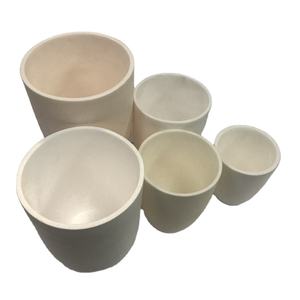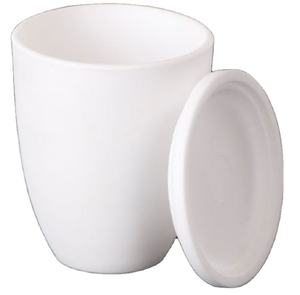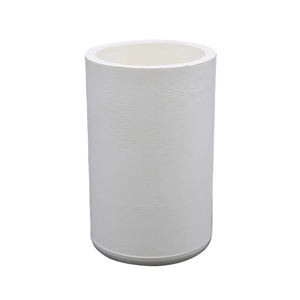Professional industry ceramic supplier, silicon nitride, silicon carbide, aluminum nitride and any other kinds of ceramics.
PRODUCT PARAMETERS
Description
Overview of Lab Melting Used Fused Silica Quartz Sio2 Ceramic Crucible
Lab Melting Used Fused Silica Quartz Sio2 Ceramic Crucible are specialized containers designed for withstanding extremely high temperatures in laboratory and industrial settings. They are essential for processes such as melting, calcining, and heat-treating a wide variety of materials, including metals, glasses, and chemicals. Our crucibles are engineered for superior thermal stability and chemical resistance, ensuring purity and reliability in the most demanding applications.
Features of Lab Melting Used Fused Silica Quartz Sio2 Ceramic Crucible
-
Exceptional Thermal Shock Resistance: Withstands rapid temperature changes without cracking, ensuring durability and a long service life.
-
High-Temperature Stability: Maintains structural integrity at extreme temperatures, often exceeding 1500°C.
-
Excellent Chemical Inertness: Resists corrosion and reaction with molten metals, acids, and aggressive chemical fluxes.
-
High Purity & Low Contamination: Manufactured from premium materials to prevent sample contamination during sensitive processes.
-
Optimized Thermal Properties: Designed for efficient heat transfer and consistent performance in furnace environments.
-
Robust Mechanical Strength: Offers good resistance to physical impact and abrasion during handling and use.
Specifications of Lab Melting Used Fused Silica Quartz Sio2 Ceramic Crucible
This integrated silica quartz crucible is for laboratory melting. It’s made from pure silicon dioxide (SiO2). The product is glass-like. It takes care of high warmth well. You can utilize it up to 1100 ° C constantly. It endures brief ruptureds even hotter. It resists abrupt temperature level adjustments. This indicates less cracking from thermal shock. That is necessary for home heating and cooling cycles.
Chemical resistance is very good. Acids don’t bother it much. Many bases are alright too. This makes it functional. You can thaw various products securely. The pureness degree is high. There’s extremely little steel contamination. This is critical for delicate work. It guarantees your examples stay clean.
The crucible is available in different dimensions. Common abilities include 10ml, 25ml, 50ml, 100ml, 250ml, and 500ml. Select the dimension suitable your sample amount. The form is usually round. It could have a flat or rounded bottom. This depends upon the specific version. The wall surfaces are thick enough for toughness. They still permit excellent warmth transfer.
It operates in electrical heaters and gas stoves. It prevails for melting metals. Precious metals like silver and gold are instances. It’s additionally made use of for glasses and some ceramics. Handle it thoroughly. Avoid bumps or drops. The fused silica is tough however can break. Tidy it correctly after each use. This stops contamination following time. Follow the maker’s cleaning instructions.
Applications of Lab Melting Used Fused Silica Quartz Sio2 Ceramic Crucible
Fused silica quartz crucibles are crucial in labs. They handle heats well. These crucibles withstand thermal shock. They do not split quickly when warmed or cooled down fast. Their pureness issues. Fused silica quartz is mainly pure silicon dioxide. This pureness indicates fewer contaminations enter into your thaw. Contamination danger is reduced. They work well with several chemicals. Acids and bases normally do not attack them. They are chemically inert. This makes them risk-free for thawing numerous compounds.
Scientists use these crucibles for melting steels. Rare-earth elements like silver and gold are common examples. Base metals like copper or nickel are likewise thawed. The crucible material does not react with the liquified metal. Ceramic powders often need melting also. These crucibles manage that job. Glass frits are melted inside them. The crucible stays secure. It does not add undesirable components.
Chemistry labs count on these crucibles. They are utilized in example preparation. Examples get melted before analysis. This assists identify what the example has. Often chemicals are synthesized at high warmth. The crucible offers a tidy container. Materials science research uses them extensively. New alloys are established. Experimental ceramics are produced. The crucible holds the liquified material safely. It withstands the extreme problems.
These crucibles are difficult. They last longer than lots of other kinds. This saves money gradually. They are transparent to infrared radiation. This enables unique home heating methods. Induction furnaces can warm them directly. Their smooth surface area makes cleanup easier. Deposit does not stick terribly. After cooling, the strong material bulges conveniently. This conserves effort and time. Managing merged silica crucibles requires treatment. They are weak like glass. Dropping them can cause damage. Always utilize proper tongs. Secure your eyes and skin. Adhere to all lab safety and security guidelines.
Company Profile
Tanki New Materials Co.Ltd. focus on the research and development, production and sales of ceramic products, serving the electronics, ceramics, chemical and other industries. Since its establishment in 2015, the company has been committed to providing customers with the best products and services, and has become a leader in the industry through continuous technological innovation and strict quality management.
Our products includes but not limited to Aerogel, Aluminum Nitride, Aluminum Oxide, Boron Carbide, Boron Nitride, Ceramic Crucible, Ceramic Fiber, Quartz Product, Refractory Material, Silicon Carbide, Silicon Nitride, ect. please feel free to contact us.

Payment Methods
T/T, Western Union, Paypal, Credit Card etc.
Shipment Methods
By air, by sea, by express, as customers request.
5 FAQs of Lab Melting Used Fused Silica Quartz Sio2 Ceramic Crucible
This crucible melts stuff in labs. It’s made from fused silica quartz. People call it SiO2 ceramic too.
What is this crucible made from?
It’s fused silica quartz. That’s pure silicon dioxide. This material resists heat well. It handles chemicals too. Acids don’t hurt it much. Bases are tougher on it. This makes it good for melting many things.
What do labs use it for?
Labs melt metals inside it. They melt glass sometimes. Ceramics get melted too. It works with high heat processes. It holds the melted stuff safely. People need a container that won’t break easily.
How hot can it get?
It handles very high temperatures. It’s good up to about 1650°C. Don’t push it past that point. It might crack or break. Sudden temperature changes are bad. Heat it up slowly. Cool it down slowly too. This keeps it strong.
How do I clean it?
Clean it after each use. Let it cool down first. Use water or special acid washes. Don’t use strong alkalis. They can damage the surface. Scrub gently if needed. Dry it completely before storage. Keep it in a dry place.
When should I replace it?
Look for cracks or chips. Deep scratches are bad too. If it looks cloudy or rough, replace it. It might leak or break soon. It gets weaker over time. Don’t use a damaged crucible. It’s not safe. Buy a new one then.
REQUEST A QUOTE
RELATED PRODUCTS

High Temperature Resistance Alumina Ceramic Crucible with Lid

High Temperature Carbon Sulfur Analyzer SiO2 Silica Ceramic Crucible

ZrO2 Crucible /Zirconia Ceramic Boat Crucibles with Lid

Stackable Cordierite Mullite Ceramic Sagger Crucible and Saggar for Sintering

Customized Whole High Quality TIB2 Ceramic Thermal Shock Resistance Molten Meta Titanium Diboride Crucible



